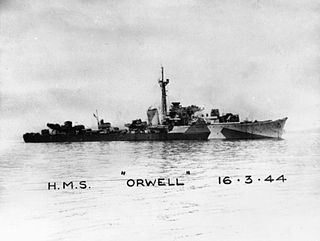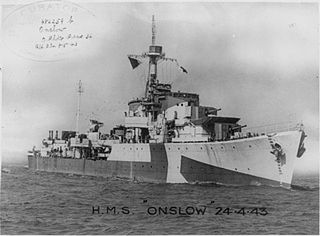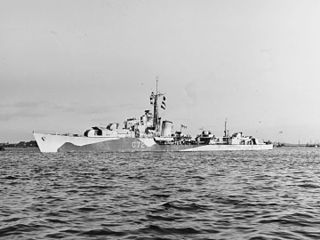Related Research Articles

The Battle of the North Cape was a Second World War naval battle that occurred on 26 December 1943, as part of the Arctic campaign. The German battleship Scharnhorst, on an operation to attack Arctic convoys of war materiel from the western Allies to the Soviet Union, was brought to battle and sunk by the Royal Navy's battleship HMS Duke of York with cruisers and destroyers, including an onslaught from the destroyer HNoMS Stord of the exiled Royal Norwegian Navy, off the North Cape, Norway.

The Battle of the Barents Sea was a World War II naval engagement on 31 December 1942 between warships of the German Navy (Kriegsmarine) and British ships escorting Convoy JW 51B to Kola Inlet in the USSR. The action took place in the Barents Sea north of North Cape, Norway. The German raiders' failure to inflict significant losses on the convoy infuriated Hitler, who ordered that German naval strategy would henceforth concentrate on the U-boat fleet rather than surface ships.

HMS Saumarez was an S-class destroyer of the Royal Navy, completed on 1 July 1943. As a flotilla leader, her standard displacement was 20 tons heavier than other ships of her class. She continued the tradition of flotilla leaders being named after prominent British seamen, in her case Vice-Admiral James Saumarez, 1st Baron de Saumarez of the late 18th and early 19th centuries.

HMS Orwell was an O-class destroyer of the Royal Navy that entered service in 1942 and was broken up in 1965.

HMS Onslow was an O-class destroyer of the Royal Navy. The O-class were intermediate destroyers, designed before the outbreak of the Second World War to meet likely demands for large number of destroyers. They had a main gun armament of four 4.7 in guns, and had a design speed of 36 kn. Onslow was ordered on 2 October 1939 and was built by John Brown & Company at their Clydebank, Glasgow shipyard, launching on 31 March 1941 and completing on 8 October 1941.

Convoy JW 58 was an Arctic convoy sent from Great Britain by the Western Allies to aid the Soviet Union during World War II. It sailed in March 1944, reaching the Soviet northern ports in early April. All ships arrived safely. JW 58 was attacked by German U-boat and aircraft but suffered no losses. Three U-boats were destroyed and six aircraft were shot down during these operations.

Convoy JW 57 was an Arctic convoy sent from Great Britain by the Western Allies to aid the Soviet Union during World War II. It sailed in February 1944, reaching the Soviet northern ports at the end of the month. All ships arrived safely. For several days JW 57 was attacked by a German U-boat force; one escort vessel was sunk, and two U-boats were destroyed in counter-measures, during this operation.
Convoy JW 56A was an Arctic convoy sent from Great Britain by the Western Allies to aid the Soviet Union during World War II. It sailed in January 1944, reaching the Soviet northern ports at the end of the month. Twelve ships arrived safely. During the voyage JW 56A was attacked by a German U-boat force; three ships were sunk and one of the escorts damaged in the operation.

Convoy JW 56B was an Arctic convoy sent from Great Britain by the Western Allies to aid the Soviet Union during World War II. It sailed in late January 1944, reaching the Soviet northern ports at the beginning of February. All ships arrived safely. During the voyage JW 56B was attacked by a German U-boat force; no merchant ships were sunk, though one of the escorts was lost. One attacking U-boat was destroyed in the operation.
Convoy JW 55A was an Arctic convoy sent from Great Britain by the Western Allies to aid the Soviet Union during World War II. It sailed in December 1943, reaching the Soviet northern ports at the end of the month. All ships arrived safely.

Convoy JW 55B was an Arctic convoy sent from Great Britain by the Western Allies to aid the Soviet Union during World War II. It sailed in late December 1943, reaching the Soviet northern ports at the end of the month. All ships arrived safely.
Convoy RA 55B was an Arctic convoy during World War II. It was one of a series of convoys run to return Allied ships from Soviet northern ports to ports in Britain. It sailed at the end of December 1943, reaching British ports in early January 1944. All ships arrived safely.
Convoy JW 54A was an Arctic convoy sent from Great Britain by the Western Allies to aid the Soviet Union during World War II. It sailed in November 1943, reaching the Soviet northern ports at the end of the month. JW 54A was the first out-bound Arctic convoy of the 1943–44 winter season, following their suspension during the summer. All ships arrived safely.
Convoy JW 54B was an Arctic convoy sent from Great Britain by the Western Allies to aid the Soviet Union during World War II. It sailed in late November 1943, reaching the Soviet northern ports at the end of the month. All ships arrived safely.
Convoy JW 51A was an Arctic convoy sent from Great Britain by the Western Allies to aid the Soviet Union during World War II. It sailed in December 1942, reaching the Soviet northern ports at the end of the month.
Convoy JW 51B was an Arctic convoy sent from United Kingdom by the Western Allies to aid the Soviet Union during the Second World War. It sailed in late December 1942, reaching the Soviet northern ports in early January 1943.

Arctic naval operations of World War II were the World War II naval operations that took place in the Arctic Ocean, and can be considered part of the Battle of the Atlantic and/or of the European Theatre of World War II.

HMS Whitehall, pennant number D94, later I94, was a Modified W-class destroyer of the British Royal Navy that saw service in the Second World War.

HMS Scorpion was an S-class destroyer of the Royal Navy, the eleventh of her name, commissioned on 11 May 1943. Initially she was to be named Sentinel, but this was changed following the loss of the Dragonfly-class river gunboatScorpion in the Bangka Strait in February 1942. She served in the Royal Navy during the Second World War, mostly in the Arctic Ocean, and fought in the Battle of North Cape. She was sold to the Netherlands in 1945 and scrapped in 1963.

HMS Dianella was a Flower-class corvette of the Royal Navy. She served during the Second World War.
References
- Kemp, Paul (1993). Convoy! Drama in Arctic Waters. London: Arms and Armour Press. ISBN 1-85409-130-1.